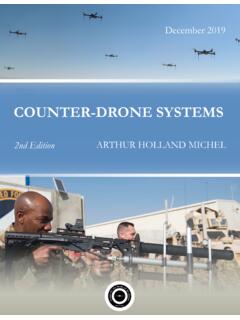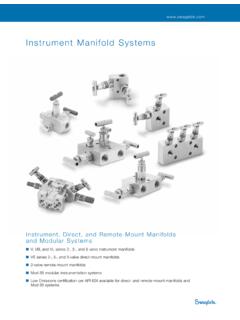Transcription of COUNTER-DRONE SYSTEMS
1 COUNTER-DRONE SYSTEMSA rthur Holland Michel February 2018 ABOUT THE CENTER FOR THE STUDY OF THE DRONEThe Center for the Study of the Drone at Bard College is an interdisciplinary research institution that examines the novel and complex opportunities and challenges presented by unmanned SYSTEMS technologies in both the military and civilian sphere. By conducting original, in-depth, and inquiry-driven projects, we seek to furnish stakeholders, policy-makers, and the public with the resources to engage in a robust public debate and develop policies that best address those opportunities and by Dan Gettinger.
2 Editorial support provided by Karin Roslund. Research support provided by Aasiyah Ali, Lynn Barnett, Dylan Sparks, Josh Kim, and John McKeon. Presentation by Dan Blades, Senior Industry Analyst, Frost & Sullivan, provided assistance in the development of this database. Frost & Sullivan s market reports on C-UAS technology are available for purchase here (defense) and here (commercial).Holland Michel, Arthur. COUNTER-DRONE SYSTEMS . Center for the Study of the Drone at Bard College, Feburary 20, 2018, 2018 Center for the Study of the Drone at Bard CollegeCounter-drone technology, also known as counter-UAS, C-UAS, or counter-UAV technology, refers to SYSTEMS that are used to detect and/or intercept unmanned aircraft.
3 As concerns grow around the potential security threats drones may pose to both civilian and military entities, a new market for COUNTER-DRONE technology is rapidly emerging. To date, we have found at least 235 COUNTER-DRONE products either on the market or under active development. This report provides background on the growing demand for C-UAS technology, describes how the technology works, presents our database of known C-UAS SYSTEMS from around the globe, and explains some of the challenges surrounding count-er-drone technology use. The C-UAS industry has grown exponentially in recent years. We have identified over 230 C-UAS products produced by 155 manufacturers in 33 countries; The most popular drone detection techniques are radar, RF detection, EO, and IR.
4 The most popular interdiction technique is jamming; C-UAS technology poses a wide range of practical, legal, and policy challenges in all operating environments; A lack of common standards in the C-UAS industry means that there is a wide variance in the effectiveness and reliability of groups have pondered the issue of how to counter unmanned aircraft for several years. For exam-ple, in 2003, NATO launched a ten-year study on how to defend against low, slow, and small aerial targets using ground-based defense SYSTEMS (the resulting report has not been publicly released). In 2008, RAND Corpora-tion published a seminal report on the threat posed by unmanned aircraft to the , which helped define the contours of the In the ensuing years, a wide range of organizations, labs, and private firms have weighed in on the threat of unmanned aircraft and what to do about growth of C-UAS technology is directly tied to mounting concerns about the threat that drones pose both in civilian and wartime environments.
5 In the military domain, small drones have been proliferating at a rate that has alarmed battlefield commanders and planners alike. In the conflict in Syria and Iraq, at least half a dozen groups operate a wide variety of drones, which give even the most poorly funded actors an aerial command of the battlespace that can prove decisive in For example, ISIS has used drones to help guide vehicle-borne IEDs more accurately toward their targets. Some of these same groups have success-fully armed drones with explosive ord-nance, effectively converting cheap hobby kits into rudimentary yet potentially lethal guided missiles.
6 Last year, ISIS claimed to BACKGROUND have carried out more than 200 such attacks in just 12 In January, an unknown group launched over a dozen such drones in a coordinated attack against two Russian military installations in Though the offensive was ultimately unsuccessful, it demonstrated the growing sophistication of the unmanned aircraft that are increasingly finding their way into war zones across the globe. Even when these attacks are unsuccessful, they still create serious challenges for belligerents on the ground and in the air; there are so many drones operating in the conflict in Syria and Iraq that one Army official even said that the has no control of the airspace below 3,500 feet in the The conflict in Ukraine is another important case study on the impact of small unmanned aircraft in modern still from an ISIS promotional video shows an armed Sky-walker X-8 fixed-wing drone.
7 KEY TAKEAWAYS1 CSD | COUNTER-DRONE GROWTHThe growth in the COUNTER-DRONE technology sector is directly correlated to these concerns. The Depart-ment of Defense significantly increased investment in C-UAS technology only after ISIS and other groups operating in the conflict in Syria and Iraq demonstrated the ability to operate a wide range of drones, including armed SYSTEMS . In 2015, after a man accidentally crashed a DJI quadcopter on the grounds of the White House, revealing that the nation s most protected site could be vulnerable to attacks from unmanned aircraft, the Secret Service began testing C-UAS SYSTEMS and techniques in Following hundreds of reports of close encounters between drones and manned aircraft in the airspace system , the FAA launched a program to test C-UAS at a number of airports.
8 Where such incidents are both most common and most After law enforcement groups raised the possibility that drones could be an effective weapon for terrorist attacks on large crowds, COUNTER-DRONE SYSTEMS began to appear around sporting and political events with increasing expansion of the sector in the roughly five years since COUNTER-DRONE SYSTEMS first appeared on the market has been stratospheric. In a market survey conducted in 2015, researchers at the Sandia National Laboratories identified just 10 dedicated COUNTER-DRONE SYSTEMS avail-able for Today, less than three years later, we have tallied over 200 SYSTEMS on the market.
9 Venture capital firms have also taken an interest in the sector, and COUNTER-DRONE technology acquisition and development is now the fastest-growing drone-related spending cate-gory in this year s Department of Defense One study estimates that the C-UAS market could be worth as much as $ billion in five @DroneCenter2 Many worry that similar drones could be used in ter-rorist attacks In 2013, Germany s Pirate Party flew a small multirotor drone in close proximity to Angela Merkel at an open-air rally, leading many to speculate about the ease with which a drone could attack an otherwise highly secured Sightings of drones over sensitive facilities such as a submarine base in Washington State9 and nuclear facilities in France10 have raised the specter state- and non-state-sponsored espionage.
10 Other concerns are no longer hypothetical. Around the globe, drones have become a popular tool for smuggling contraband into prisons. Meanwhile, near misses between drones and manned aircraft have become a common occurrence in every crowded airspace system in the world, and many worry that a collision between a manned aircraft and an unmanned aircraft could result in a catastrophic air defense SYSTEMS that have traditionally been used to protect airspace from manned aircraft are generally ineffective against drones. Military anti-aircraft radars are mostly designed to detect large, fast moving objects.






